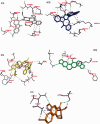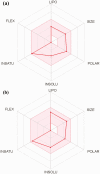Alkaloids and flavonoids from African phytochemicals as potential inhibitors of SARS-Cov-2 RNA-dependent RNA polymerase: an in silico perspective
- PMID: 33372806
- PMCID: PMC7783895
- DOI: 10.1177/2040206620984076
Alkaloids and flavonoids from African phytochemicals as potential inhibitors of SARS-Cov-2 RNA-dependent RNA polymerase: an in silico perspective
Abstract
Corona Virus Disease 2019 (COVID-19) is a pandemic caused by Severe Acute Respiratory Syndrome Coronavirus-2 (SARS-CoV-2). Exploiting the potentials of phytocompounds is an integral component of the international response to this pandemic. In this study, a virtual screening through molecular docking analysis was used to screen a total of 226 bioactive compounds from African herbs and medicinal plants for direct interactions with SARS-CoV-2 RNA-dependent RNA polymerase (RdRp). From these, 36 phytocompounds with binding affinities higher than the approved reference drugs (remdesivir and sobosivir), were further docked targeting the active sites of SARS-CoV-2, as well as SARS-CoV and HCV RdRp. A hit list of 7 compounds alongside two positive controls (remdesivir and sofosbuvir) and two negative controls (cinnamaldehyde and Thymoquinone) were further docked into the active site of 8 different conformations of SARS-CoV-2 RdRp gotten from molecular dynamics simulation (MDS) system equilibration. The top docked compounds were further subjected to predictive druglikeness and ADME/tox filtering analyses. Drugable alkaloids (10'-hydroxyusambarensine, cryptospirolepine, strychnopentamine) and flavonoids (usararotenoid A, and 12α-epi-millettosin), were reported to exhibit strong affinity binding and interactions with key amino acid residues in the catalytic site, the divalent-cation-binding site, and the NTP entry channel in the active region of the RdRp enzyme as the positive controls. These phytochemicals, in addition to other promising antivirals such as remdesivir and sofosbuvir, may be exploited towards the development of a cocktail of anti-coronavirus treatments in COVID-19. Experimental studies are recommended to validate these study.
Keywords: RNA-dependent RNA polymerase; SARS-CoV-2; alkaloids; flavonoids; phytochemicals.
Conflict of interest statement
Figures







Similar articles
-
Exploring Erythrina flavonoids as potential SARS-CoV-2 RdRp inhibitors through virtual screening, in silico ADMET evaluation, and molecular dynamics simulation studies.Sci Rep. 2025 Apr 24;15(1):14259. doi: 10.1038/s41598-025-97311-w. Sci Rep. 2025. PMID: 40274940 Free PMC article.
-
Potential inhibitors of coronavirus 3-chymotrypsin-like protease (3CLpro): an in silico screening of alkaloids and terpenoids from African medicinal plants.J Biomol Struct Dyn. 2021 Jun;39(9):3396-3408. doi: 10.1080/07391102.2020.1764868. Epub 2020 May 18. J Biomol Struct Dyn. 2021. PMID: 32367767 Free PMC article.
-
Virtual screening of phytochemicals by targeting multiple proteins of severe acute respiratory syndrome coronavirus 2: Molecular docking and molecular dynamics simulation studies.Int J Immunopathol Pharmacol. 2022 Jan-Dec;36:3946320221142793. doi: 10.1177/03946320221142793. Int J Immunopathol Pharmacol. 2022. PMID: 36442514 Free PMC article.
-
Investigating the potential of natural compounds as novel inhibitors of SARS-CoV-2 RdRP using computational approaches.Biotechnol Genet Eng Rev. 2024 Nov;40(3):1535-1555. doi: 10.1080/02648725.2023.2195240. Epub 2023 Mar 30. Biotechnol Genet Eng Rev. 2024. PMID: 36994810 Review.
-
Potential Candidates against COVID-19 Targeting RNA-Dependent RNA Polymerase: A Comprehensive Review.Curr Pharm Biotechnol. 2022;23(3):396-419. doi: 10.2174/1389201022666210421102513. Curr Pharm Biotechnol. 2022. PMID: 33882805 Review.
Cited by
-
The naturally-derived alkaloids as a potential treatment for COVID-19: A scoping review.Phytother Res. 2022 Jul;36(7):2686-2709. doi: 10.1002/ptr.7442. Epub 2022 Mar 30. Phytother Res. 2022. PMID: 35355337 Free PMC article.
-
Novel Drug Design for Treatment of COVID-19: A Systematic Review of Preclinical Studies.Can J Infect Dis Med Microbiol. 2022 Sep 25;2022:2044282. doi: 10.1155/2022/2044282. eCollection 2022. Can J Infect Dis Med Microbiol. 2022. PMID: 36199815 Free PMC article. Review.
-
In silico investigation to identify potential small molecule inhibitors of the RNA-dependent RNA polymerase (RdRp) nidovirus RdRp-associated nucleotidyltransferase domain.Chem Phys Lett. 2021 Sep 16;779:138889. doi: 10.1016/j.cplett.2021.138889. Epub 2021 Jul 12. Chem Phys Lett. 2021. PMID: 34305155 Free PMC article.
-
Implication of in silico studies in the search for novel inhibitors against SARS-CoV-2.Arch Pharm (Weinheim). 2022 May;355(5):e2100360. doi: 10.1002/ardp.202100360. Epub 2022 Mar 4. Arch Pharm (Weinheim). 2022. PMID: 35244237 Free PMC article. Review.
-
In silico evaluation of potential intervention against SARS-CoV-2 RNA-dependent RNA polymerase.Phys Chem Earth (2002). 2023 Feb;129:103350. doi: 10.1016/j.pce.2022.103350. Epub 2022 Dec 15. Phys Chem Earth (2002). 2023. PMID: 36536697 Free PMC article.
References
-
- Porcheddu R, Serra C, Kelvin D, et al. Similarity in case fatality rates (CFR) of COVID-19/SARS-COV-2 in Italy and China. J Infect Dev Ctries 2020; 14: 125–128. - PubMed
MeSH terms
Substances
LinkOut - more resources
Full Text Sources
Research Materials
Miscellaneous

